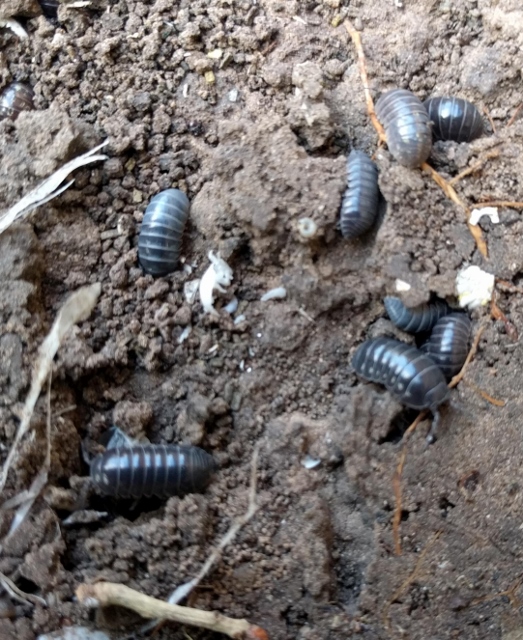
Many of us have fond childhood memories of playing with roly-poly bugs (Armadillidium vulgare)—also called pill bugs, woodlice, sow bugs or doodlebugs—those tiny, tough, multi-legged creatures that roll up into a ball.
My three-year-old grandson snatches up the little black pills—troubled when they do not
promptly curl up—then nudges them to freedom from his palm. As a child, Brenda Peña of Brownsville loved “their little legs”, their texture, and how they tickled. Brownsville resident Clem Hernandez said she “adored roly-polys”; she played with them “endlessly in the dirt”, keeping them briefly in a little bucket.
Though it’s natural to mistake roly-polys for insects, a cursory glance reveals more than six legs. Nor are they arachnids, which have eight. Roly-polys are not bugs at all; they are in an order of crustaceans, called isopods, flat-bodied creatures with seven identical pairs of legs, “iso” meaning equal, “pod” meaning feet. They are more closely related to crabs and shrimp than beetles.
Roly-polys have gills, not lungs and, though unable to swim, must struggle mightily to remain moist. Being nocturnal, they spend days burrowing beneath boards, rocks, soil, leaves and potted plants to avoid heat and its resultant dehydration. Roly-polys can also
absorb moisture from the air. Exposed roly-polys will die in temperatures above 97 degrees.
A roly-poly’s flexible shell, a set of seven segmented plates, allows it to roll up, a process called conglobation, as a defense against predators—lizards, birds, toads, centipedes, and spiders. However, the woodlouse spider, which inhabits Texas, but not the Valley, can pierce the shell with its powerful fangs. To discourage predators, roly-polys also can release a foul-smelling and tasting liquid.
Roly-polys, like insects, have three body parts—a head, a pereon, akin to a thorax, and a pleon, like an abdomen. Roly-polys consume water, as from a straw, and expel gas from two uropods, protrusions from their abdomens. Gills, visible white patches, rest between the legs and uropods. Their heads sport two pairs of antennae.
Having only a rudimentary sense of sight—it can only detect light or its absence—smell and touch, roly-polys interact with their world chiefly with chemical sensing, with which they create trails for locating habitat and mates.
Perceiving danger, roly-polys move forward, turning slightly to the right, then to the left. They appear to move faster in drier periods, seeking shelter more frequently.
These hardy, adaptable creatures originally hale from the Mediterranean Basin but now inhabit a variety of subtropical, tropical and temperate habitats, hibernating when faced with cold.
Roly-poly pairs form a few days before mating, which occurs in spring, but year-round in warm climates. Males climb atop females, transferring sperm to their gonopores, or genital openings, with their initial pair of legs. In her oviducts, or tubes, sperm are immobilized into bundles. Females can store sperm for a year, the older bundles being used first.
The mother keeps up to 200 eggs inside from two to three months until the mancas, or babies, hatch, remaining in her pouch a few weeks before exiting. The white-colored young remain nearby until their shells harden and their last legs—they are born with a mere six—grow as they repeatedly molt, or shed their shells, gradually darkening. The back half slides off first, followed a few days later by the front section, so the creature is never completely vulnerable. Throughout their two to three-year lives, roly-polys continue molting. A two-colored roly-poly is in mid-molt.
Roly-polys carry no diseases, nor do they bite or sting. And, though they may eat plants or edible roots like carrots, they do far more good than harm. Since they consume decaying leaves, dung, dirt and seeds, they enrich soil, scatter seeds and help control weeds. Roly-polys, which help rid soil of harmful metals, consume copper, lead, cadmium, and zinc; they can thrive even in contaminated soils. Not only are roly-polys, being easily maintained, popular pets, but terrarium owners find them to serve as excellent clean-up crews.
While exploring roly-poly habitats underneath rocks and such, one must take care not to disturb other less benign creatures, for instance, the poisonous brown recluse spider, scorpions, or the large (9-12 inches), aggressive Texas red-headed centipede, with its painful bite, venomous but generally not deadly. Researchers don gloves.
Naturally, I fret about fellow creatures who struggle to survive due to our lack of consideration. Yet, I celebrate those like these benign, adaptable roly-polys who have not only endured but have managed to populate a huge portion of the world.